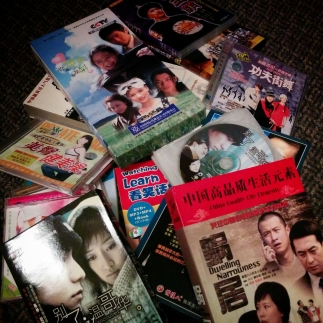Crosstalk is a term for multilingual communication where each person speaks their own language, using non-verbal tools as needed to make themselves understood.
It can be used to implement the Automatic Language Growth approach to language learning, which theorizes that adults can learn languages as well and as effortlessly as children do if they learn them like children—by picking them up through experience instead of study, and listening and understanding before speaking much.
Dr. J. Marvin Brown, the originator of ALG, found the adult propensity to try to speak a new language before having a sufficient foundation of listening experience to be responsible for many of the problems adult language learners face, such as pronunciation difficulties and “broken” grammar.
Seeing the pressure his students faced to speak from early on, Brown developed Crosstalk as a way for them to gain more listening experience and communicate with speakers of their target language without having to speak it themselves.
More than just a language learning technique, Crosstalk is a way for people who don’t share the same language to overcome this language barrier and effectively communicate.
I have used Crosstalk in a variety of contexts, and while I haven’t succeeded in fully implementing it, I have picked up language through using it, and I think it holds an enormous potential for both language learning and communication that could be realized if it’s developed and widely applied.
Learning Mandarin with ALG

Most of my experience with Crosstalk comes from when I first used it while attempting to learn Mandarin Chinese using the ALG approach.
Starting almost totally from scratch, I had been watching videos like drama series and cartoons in Mandarin for about a year-and-a-half.
In keeping with ALG, I was attempting to learn implicitly, simply listening and guessing at what was being said without study or translation.
After a couple hundred hours, I had picked up what some words meant, and after a few hundred hours more, I was able to follow some conversations in detail.
But I realized that I was not picking up Mandarin very efficiently from these shows because they didn’t provide enough context to make the language understandable, unlike the AUA Thai Program, where the ALG method has mainly been implemented.
I wanted something more effective, but couldn’t find materials or classes for Mandarin that would allow me to pick up the language without the use of translation or other conscious study of language.
After watching close to 1000 hours of videos, I decided to try Crosstalk as a way to move forward.
Crosstalk with a Chinese tutor
I contacted a local Chinese tutor whom I had found online, we met up, and I explained the basics of Crosstalk to him: I wanted him to speak only Mandarin to me, using pictures and gestures to get the meaning across, while I would speak English to him.
I told him if I didn’t understand something, rather than translating or explaining in English, he should use non-verbal communication and explain in Mandarin using different words or examples.
Our first Crosstalk conversation ended up going surprisingly smoothly and I was impressed with my tutor’s ability to communicate with the help of gestures and acting.
When I asked him about his hobbies, he talked enthusiastically about them, and soon we were having a normal conversation about our interests, but with me speaking English and him speaking Mandarin.
This is the aim of both Crosstalk and ALG: a focus on communication rather than language or teaching, where language is acquired naturally through understanding.

- A page of drawings from a Crosstalk session with a Chinese tutor
We met for many Crosstalk sessions of up to four hours in length, most involving free-flowing discussions of various topics.
Our main tools for communication and context were pen and paper to draw things, a computer to pull up images and maps on, and local Chinese newspapers that he often brought in, which helped provide fodder for discussion.
Occasionally for these sessions, we would make a Chinese dish or go somewhere together like Toronto’s Chinatown, or a Chinese mall or restaurant.
I gained a lot from our sessions, both in my understanding of Mandarin and experience with Crosstalk, but in retrospect I could have planned them out to be more effective.
I could have used more visual materials as the basis for our discussions and to aid my comprehension, instead of the newspapers that mainly contained Chinese text and often provoked conversation that, while potentially interesting, was often too abstract and advanced to be highly comprehensible and efficient for learning.
Also, while my tutor was naturally quite a good communicator who could tell entertaining stories and talk with passion, I could have instructed him more on the kind of techniques that would be helpful and what things to avoid, such as writing down a word I didn’t understand with Chinese characters.
After some 100 hours of these Crosstalk sessions with my tutor in person, I looked for tutors I could meet with online and found many through a language exchange site.
Using Crosstalk with online tutors
I contacted several tutors though the site italki and explained to them that I didn’t want to study Mandarin but just wanted to practice listening, so I would speak English and they would speak Mandarin.
In many cases they didn’t use video, and even with video there wasn’t much room for non-verbal communication, so I mainly asked them to not translate if I didn’t understand, but rather elaborate in Mandarin using other words and examples until I understood.
I found that by this stage my comprehension of Mandarin had grown enough that even though the lessons were mainly or only audio, we could have Crosstalk conversations that went very smoothly with few breakdowns in communication.
On occasion, I was surprised to find that I could still follow most of what the tutor was saying in Mandarin even though the connection was breaking up horribly.
I attribute this ability to the extensive listening experience that both videos and Crosstalk gave me, which taught me to use context and listen for meaning, and helped me to be able to reconstruct language from imperfect input.

Later on I did sometimes use an app called IDroo that worked with Skype with some tutors, allowing us to draw on a virtual whiteboard and share and annotate things like pictures and maps.
Overall I did about 150 hours of Crosstalk online, trying different tutors and sticking with a few who fit my schedule and were enthusiastic speakers who could communicate well.
Finding a real Crosstalk language exchange
While I was using Crosstalk successfully in person and online, it was with tutors whom I was paying who already were functional in English, not the ideal experience I wanted of a language exchange where we were each communicating and picking up each other’s language.
Looking for real exchanges like this, I volunteered as a tutor for a conversation class for Chinese newcomers to Canada, in hopes of helping people with their English while acquiring Mandarin at the same time.
I didn’t find much opportunity to do so in the classes themselves, which were only an hour-and-a-half per week and mainly involved discussions in English with worksheets that contained mainly English text.
However, I was able to use some of the non-verbal communication techniques I was familiar with through ALG and Crosstalk to help those students whose English level was low and couldn’t follow the discussions and texts.
One of these students wanted me to help her more with her English, so we arranged to meet outside of class at a library.
I tried to explain the Crosstalk method to her, as I had with my tutors, but it was more difficult because of her low comprehension in English.
Although she would tend to mix English she knew with her Mandarin frequently, we were able to do Crosstalk with some success.
I talked about life in Canada, and she shared interesting stories about her life in China in decades past.
Interestingly, after just a few hours of Crosstalk with me, she commented that her comprehension of my English had improved.
However, she also expressed in Chinese that she thought she was inconveniencing me by having me come and tutor her for free.
I tried to explain that we could both benefit using Crosstalk, improving in our second languages the more hours we spent on it, but it was no avail, and our meetings tapered off.
What I learned (besides Mandarin)
Looking back I would have done many things differently in using Crosstalk as part of learning Mandarin Chinese.
I would have started working with tutors earlier in my learning, instead of putting it off partly out of concern that I did not have enough comprehension of Mandarin to use Crosstalk effectively at earlier stages in my learning.
I could have worked with the tutors and focused on highly visual materials in our discussions, and with a narrower focus on discussion topics to improve repetition and comprehensibility.
This would have helped me gain more language sooner, that would increase my comprehension of the TV shows I was watching and thus what I could gain from them.
At the same time, I could have started earlier with finding people who I could do true Crosstalk language exchanges with, and have been more persistent in setting these up.
Given the great number of Chinese immigrants in the area where I lived, I’m sure I could have found many more Crosstalk partners through various avenues.
My next experiences with Crosstalk came after I put my Mandarin learning on hold to go to Thailand and see the AUA Thai Program firsthand.
If you liked this post, please consider supporting Beyond Language Learning through Patreon. You can also share this post and like Beyond Language Learning on Facebook, share this post and follow on Twitter, and subscribe to the YouTube channel. If you have your own blog or website, consider linking to Beyond Language Learning and sharing posts that will interest your readers. And if you have anything to say, please leave a comment or send a note through the contact page!
